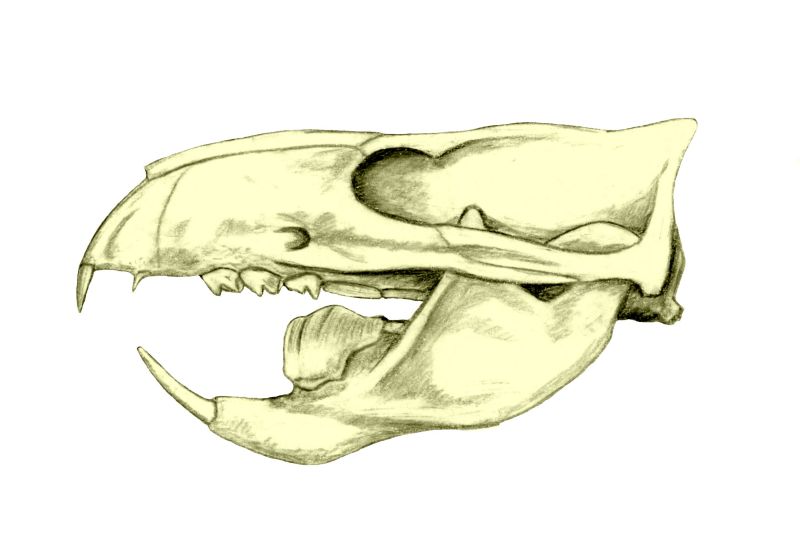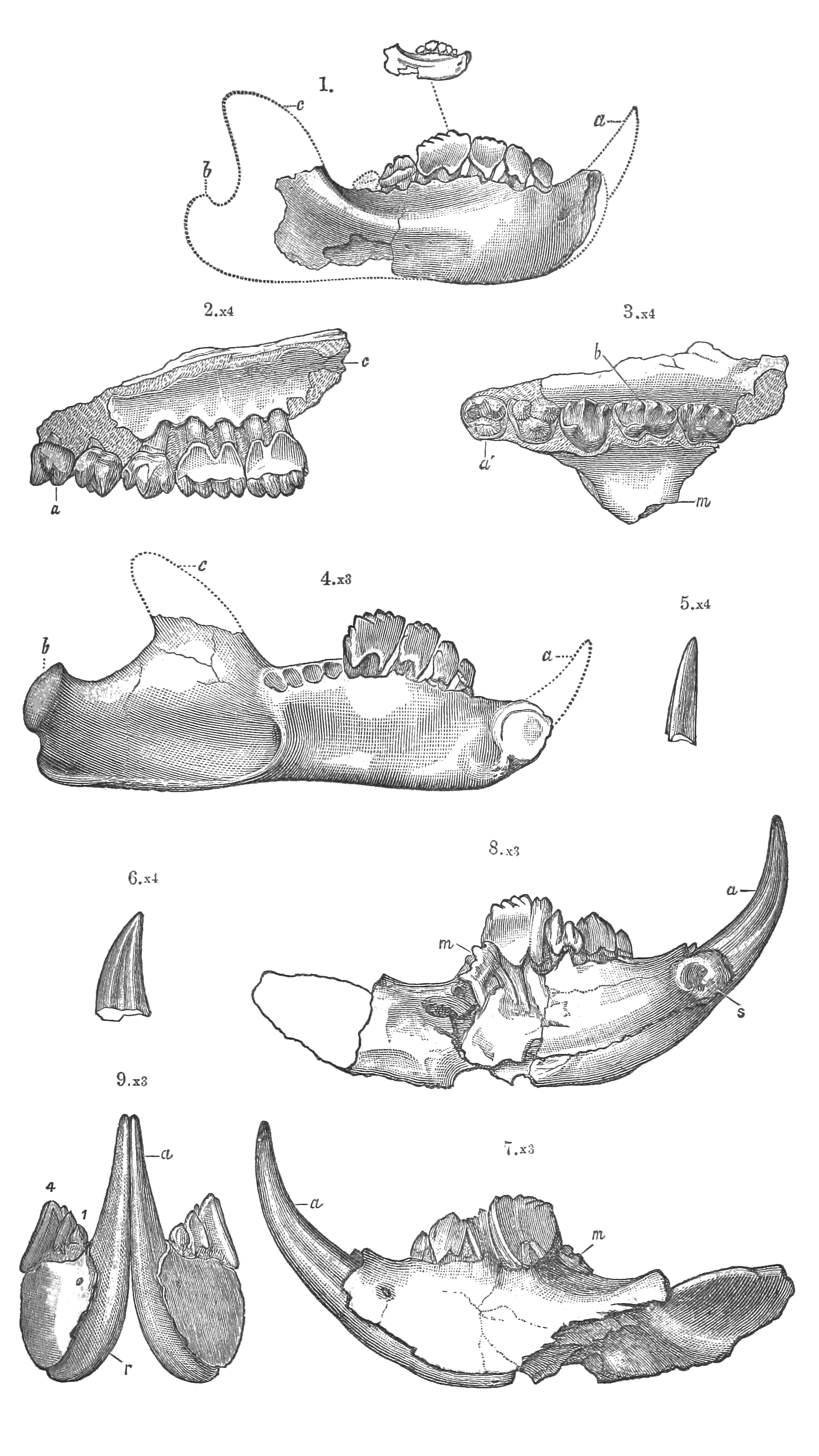Plagiaulacoid on:
[Wikipedia]
[Google]
[Amazon]
A plagiaulacoid is a type of blade-like, most often serrated, 


Teeth Mammal anatomy Dentition types
tooth
A tooth ( : teeth) is a hard, calcified structure found in the jaws (or mouths) of many vertebrates and used to break down food. Some animals, particularly carnivores and omnivores, also use teeth to help with capturing or wounding prey, tear ...
present in various mammal
Mammals () are a group of vertebrate animals constituting the class Mammalia (), characterized by the presence of mammary glands which in females produce milk for feeding (nursing) their young, a neocortex (a region of the brain), fur or ...
groups, usually a premolar
The premolars, also called premolar teeth, or bicuspids, are transitional teeth located between the canine and molar teeth. In humans, there are two premolars per quadrant in the permanent set of teeth, making eight premolars total in the mouth ...
. Among modern species it is present chiefly on diprotodontia
Diprotodontia (, from Greek language, Greek "two forward teeth") is the largest extant order (biology), order of marsupials, with about 155 species, including the kangaroos, Wallaby, wallabies, Phalangeriformes, possums, koala, wombats, and many ...
n marsupial
Marsupials are any members of the mammalian infraclass Marsupialia. All extant marsupials are endemic to Australasia, Wallacea and the Americas. A distinctive characteristic common to most of these species is that the young are carried in a po ...
s (specifically, Potoroidae
Potoroidae is a family of marsupials, small Australian animals known as bettongs, potoroos, and rat-kangaroos. All are rabbit-sized, brown, jumping marsupials and resemble a large rodent or a very small wallaby.
Taxonomy
The potoroids are s ...
, ''Bettongia
Bettongs, species of the genus ''Bettongia'', are potoroine marsupials once common in Australia. They are important ecosystem engineer, ecosystem engineers displaced during the colonisation of the continent, and are vulnerable to threatening fac ...
'' and ''Burramys
''Burramys'' is a genus of the family Burramyidae, and is represented by one living and 3 extinct (fossil) species. It is one of two genera of pygmy possum, the other being ''Cercartetus''.
Taxonomy
*Genus ''Burramys''
**†''Burramys wakefiel ...
''), which have both the upper and lower first premolars converted into serrated blades. However, various other extinct groups also possessed plagiaulacoids. These would be multituberculates
Multituberculata (commonly known as multituberculates, named for the multiple tubercles of their teeth) is an extinct order of rodent-like mammals with a fossil record spanning over 130 million years. They first appeared in the Middle Jurassic, ...
, some "Plesiadapiformes
Plesiadapiformes (" Adapid-like" or "near Adapiformes") is a group of Primates, a sister of the Dermoptera. While none of the groups normally directly assigned to this group survived, the group appears actually not to be literally extinct (in t ...
" such as ''Carpolestes
''Carpolestes'' ("fruit thief" from Ancient Greek κᾰρπός (karpós), “fruit, grain” + λῃστής (lēistḗs), “thief”) is a genus of extinct primate-like mammals from the late Paleocene of North America. It first existed arou ...
'' and various metatheria
Metatheria is a mammalian clade that includes all mammals more closely related to marsupials than to placentals. First proposed by Thomas Henry Huxley in 1880, it is a more inclusive group than the marsupials; it contains all marsupials as wel ...
ns such as '' Epidolops'' and various early diprotodontia
Diprotodontia (, from Greek language, Greek "two forward teeth") is the largest extant order (biology), order of marsupials, with about 155 species, including the kangaroos, Wallaby, wallabies, Phalangeriformes, possums, koala, wombats, and many ...
ns. In many of these only a lower premolar became converted into a blade, while the upper premolars showed less specialisation.
The various independent development of these teeth is considered a good example of convergent evolution
Convergent evolution is the independent evolution of similar features in species of different periods or epochs in time. Convergent evolution creates analogous structures that have similar form or function but were not present in the last com ...
.
Multituberculates
Multituberculata (commonly known as multituberculates, named for the multiple tubercles of their teeth) is an extinct order of rodent-like mammals with a fossil record spanning over 130 million years. They first appeared in the Middle Jurassic, ...
in particular probably own the most specialised of all plagiaulacoids. In early taxa, all lower premolars became plagiaulacoids, forming a "saw"-like arrangement. However, in Cimolodonta
Cimolodonta is a taxon of extinct mammals that lived from the Cretaceous to the Eocene. They were some of the more derived members of the extinct order Multituberculata. They probably lived something of a rodent-like existence until their ...
, premolars 1-3 degenerated and became peg-like or disappeared altogether; instead, only the fourth lower premolar remained, which increased in size. While earlier multituberculates displayed a normal tooth replacement for their plagiaulacoids, in cimolodonts this tooth was not replaced, being the last tooth to erupt and remaining through the animal's life.



Function
Most taxa with plagiaulacoids are omnivores withgranivore
Seed predation, often referred to as granivory, is a type of plant-animal interaction in which granivores (seed predators) feed on the seeds of plants as a main or exclusive food source,Hulme, P.E. and Benkman, C.W. (2002) "Granivory", pp. 13 ...
tendencies; as such, it is speculated that plagiaulacoid premolars evolved to help these mammals break or saw through tough seeds and other tough plant matter with precision, as well as to help manipulate food items in the mouth. Modern diprotodontian marsupials often use their plagiaulacoids this way.
However, many groups with plagiaulacoids have animalivorous tendencies. Various Macropodiformes
The Macropodiformes , also known as macropods, are one of the three suborders of the large marsupial order Diprotodontia. They may in fact be nested within one of the suborders, Phalangeriformes. Kangaroos, wallabies and allies, bettongs, potoro ...
and multituberculates show evidence of insectivorous and carnivorous habits, and in the latter in particular the plagiaulacoids could have been very useful meat-slicing teeth. In kogaionids the plagiaulacoid exhibits the same iron-pigmentation as the rest of the other teeth, suggesting its use in break insect
Insects (from Latin ') are pancrustacean hexapod invertebrates of the class Insecta. They are the largest group within the arthropod phylum. Insects have a chitinous exoskeleton, a three-part body ( head, thorax and abdomen), three pairs ...
exoskeletons, while multituberculate plagiaulacoid gnawing marks are known in ''Champsosaurus
''Champsosaurus'' is an extinct genus of crocodile-like choristodere reptile, known from the Late Cretaceous and early Paleogene periods of North America and Europe (Campanian-Paleocene). The name ''Champsosaurus'' is thought to come from , () ...
'' bones. In marsupial lions the plagiaulacoids became carnassial
Carnassials are paired upper and lower teeth modified in such a way as to allow enlarged and often self-sharpening edges to pass by each other in a shearing manner. This adaptation is found in carnivorans, where the carnassials are the modified f ...
teeth.
Secondary Loss
In various groups the plagiaulacoid was lost. In most cases, this is correlated to increased herbivory, especially grazing. In taeniolabidoids and some other cimolodonts the plagiaulacoid simply shrunk, while ingondwanathere
Gondwanatheria is an extinct group of mammaliaforms that lived in parts of Gondwana, including Madagascar, India, South America, Africa and Antarctica during the Upper Cretaceous through the Paleogene (and possibly much earlier, if '' Allostaffi ...
s and kangaroo
Kangaroos are four marsupials from the family Macropodidae (macropods, meaning "large foot"). In common use the term is used to describe the largest species from this family, the red kangaroo, as well as the antilopine kangaroo, eastern gre ...
s it reconverted back into a "normal" molar.Gurovich, Y.; Beck, R. (2009). "The phylogenetic affinities of the enigmatic mammalian clade Gondwanatheria". Journal of Mammalian Evolution. 16 (1): 25–49. doi:10.1007/s10914-008-9097-3.
References
{{reflistExternal links
Teeth Mammal anatomy Dentition types